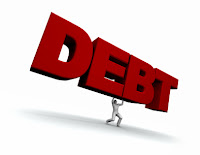 UPDATE: This post was featured in the 139th Carnival of Debt Reduction: Debtors Prison
UPDATE: This post was featured in the 139th Carnival of Debt Reduction: Debtors Prison
In our last two installments (Part 1 and Part 2), we talked about how we got into debt and laid the underpinnings of how to get out of it (stop the tide). This post is a continuation of Part 2 insofar as it concerns stopping the tide.
Part of stopping the tide is coming to grips with the fact that your debt has become a real problem.
Signs You Have a Debt Problem
- You start to do things like look for balance transfer offers from other credit card companies
- You take cash advances on one card to pay the minimum payment on another card
- You're paying only the minimum payment on all your cards
- You're up at night trying to figure out how to make it all work
- Your balances never decline by much
There are several ways to stop the tide, the first of which is to stop incurring more new debt. The only new debt you should acquire at this time is interest from your existing balances (and you most definitely want to minimize this as much as possible) or debt that replaces your existing debt at a lower interest rate.
This is where your possibilities become interesting. You can try to negotiate lower rates with your creditors. You can also try to get a debt consolidation loan. Debt consolidation loans don't always offer the best terms, but they do offer simplicity. Often times, when you find yourself with a debt problem, you begin to start making late payments. This can lead to higher interest rates as well as higher balances.
Did you know your other creditors watch your late payments to other creditors? Did you know that they could raise your rates even if you never made a late payment to them?
A debt consolidation loan (see debt consolidation) takes all of your payments and lumps them into one. So, there is no longer a convenient excuse to make late payments. However, the debt consolidation loan company is taking on a huge risk in giving you a loan; it is still unsecured debt (there are no assets backing the loan; hence greater risk of default). They are normally justified in offering you the credit you need at a higher rate than your credit card companies.
However, there is a case for them. A great resource for finding the best options in dealing with your debt problem is other debtors, and one of the best forums I've seen is the Financial Freedom Forums, where over 110,000 members share their success strategies, advice, and questions with one another. There is a special "Do It Yourself" section, complete with a creditor database, sample letters to compose for better terms from your existing creditors, and calculators.
The crux of stopping the tide, again (I cannot say this too many times), is to stop charging things. If you cannot afford to pay cash, you cannot afford it. Then, you have to assess your debt situation and make a plan. In coming posts, I will show you various methods for creating a debt elimination plan.
For right now, suffice it to say that you have to stop using the drug we call the credit card. Don't think that "This time, it will be different." It's always the same: Once addicted to something, you have to admit you are and that being addicted is causing problems for you. Then, decide to kick the habit; doing so requires a plan.
Next up in the series: Strategies for making a plan.
Technorati Tags:






0 comments
Post a Comment